Risk Assessment of Coffee Cherry (Cascara) Fruit Products for Flour Replacement and Other Alternative Food Uses
Abstract
1. Introduction
2. Materials and Methods
3. Coffee Cherry Structure and Processing
3.1. Coffee Cherry Structure
3.2. Coffee Cherry Processing
4. Chemical Characteristics of Coffee Cherry Pulp and Cascara
4.1. Caffeine
- Delayed depulping after harvesting causes the initiation of microbial fermentation processes in the coffee cherries. The delay can be produced by dry processing or by storing the coffee cherries in a bag, in water, or at room temperature in a basket for 12 h before depulping. Arpi et al. concluded from the data that microbial caffeine degradation starts after 12 to 36 h [1]. As shown in Table 1, the wet-processed sample had the highest caffeine content at 4.5 g/kg [1]. Therefore, the conclusion can be drawn from this result that wet-processed coffee cherries generally have higher caffeine content. It is also possible that this correlation occurs only when considering one coffee species at a time with its specific growth conditions, but different processing methods.
- The solvent temperature and the extraction time have a significant influence on the amount of caffeine that will be contained in the cascara-based beverage. Here, the following applies: the hotter the water and the longer it is brewed, the higher the measured caffeine content [37].
- If the cascara samples are blanched in hot water for 1 min and then dried again, the caffeine content in the subsequently brewed beverage may be up to 40% lower compared to the unblanched cascara sample [39]. Since caffeine is water-soluble, the caffeine content in the raw product can be considerably reduced with a preceding blanching step.
- Other causes of fluctuations in caffeine content may also be species and variety, the time of harvest, climatic conditions, soil properties, and geographical altitude. For example, Belitz et al. [11] show that roasted coffee beans from C. canephora have a caffeine content of 2.4%, which is almost twice that of C. arabica.
4.2. Epigallocatechin Gallate
4.3. Trigonelline
- As observed in the experiment by Cangussu et al. [39], the trigonelline content in coffee cherry husks can be almost halved if they are pretreated with a blanching step. The reason for this is the water solubility of trigonelline.
- The measured values indicate that more trigonelline is enriched in the coffee cherry pulp than in the parchment.
- There are definitely species-specific variations in trigonelline content. The contents are usually only indicated for coffee beans, and studies on the chemical composition of coffee cherry components are still needed. It can be seen that the trigonelline content in C. arabica beans is higher than in those of C. canephora [57]. Additionally, the trigonelline content decreases during roasting [58]. A transfer of the data to the coffee cherry pulp and husk would be inappropriate, since an inverse relationship is already known for the caffeine content: coffee beans of C. canephora contain more caffeine than C. arabica [11], while the coffee cherry pulp of C. arabica contains more caffeine than C. canephora [37].
- The content of trigonelline increases with the geographical altitude. This was measured in green coffee beans from C. canephora plants cultivated at different altitudes [51]. The difference is up to 25% more trigonelline in a plant grown at a higher altitude compared to one grown at a medium to low altitude. This is probably related to the function of trigonelline in adapting the coffee plant to stress situations.
5. Coffee Cherry Food Products
5.1. Juice
5.2. Jam
5.3. Jelly
“‘Jelly’ is an appropriately gelled mixture of sugars and the juice and/or aqueous extracts of one or more kinds of fruit. The quantity of juice and/or aqueous extracts used in the manufacture of 1000 g of finished product must not be less than that laid down for the manufacture of jam. These quantities are calculated after deduction of the weight of water used in preparing the aqueous extracts”.[54]
5.4. Puree
5.5. Powder/flour
6. Exposure Assessment
6.1. Exposure to Caffeine
6.2. Exposure to Epigallocatechin Gallate
6.3. Exposure to Trigonelline
7. Conclusions
Author Contributions
Funding
Institutional Review Board Statement
Informed Consent Statement
Data Availability Statement
Acknowledgments
Conflicts of Interest
References
- Arpi, N.; Muzaifa, M.; Sulaiman, M.I.; Andini, R.; Kesuma, S.I. Chemical characteristics of cascara, coffee cherry tea, made of various coffee pulp treatments. IOP Conf. Ser. Earth Environ. Sci. 2021, 709, 012030. [Google Scholar] [CrossRef]
- Maxwell, G.W. Poor mans coffee? Yemeni qishr, qahwa and qat. Tea Coffee Trade J. 1996, 168, 64–69. [Google Scholar]
- Zeckel, S.; Susanto, P.C.; Erfiani, N.M.D. Market potential of cascara tea from Catur village Kintamani Bali. 2019. International Conference on Fundamental and Applied Research (I-CFAR). Available online: https://jurnal.undhirabali.ac.id/index.php/icfar/article/view/1061 (accessed on 30 November 2022).
- Murthy, P.S.; Madhava Naidu, M. Sustainable management of coffee industry by-products and value addition—A review. Res. Conserv. Recyc. 2012, 66, 45–58. [Google Scholar] [CrossRef]
- Franca, A.S.; Oliveira, L.S. Coffee Processing Solid Wastes: Current Uses and Future Perspectives; Nova Science Publishers, Inc.: New York, NY, USA, 2009; ISBN 978-1-60741-305-9. [Google Scholar]
- International Coffee Organization. International Coffee Organization—Trade Statistics Tables. Available online: https://www.ico.org/trade_statistics.asp (accessed on 26 August 2022).
- Beyene, A.; Kassahun, Y.; Addis, T.; Assefa, F.; Amsalu, A.; Legesse, W.; Kloos, H.; Triest, L. The impact of traditional coffee processing on river water quality in Ethiopia and the urgency of adopting sound environmental practices. Environ. Monit. Assess. 2012, 184, 7053–7063. [Google Scholar] [CrossRef]
- European Food Safety Authority. Technical Report on the notification of dried cherry pulp from Coffea arabica L. and Coffea canephora Pierre ex A. Froehner as a traditional food from a third country pursuant to Article 14 of Regulation (EU) 2015/2283. EFSA J. 2021, 18, 6808E. [Google Scholar] [CrossRef]
- Klingel, T.; Kremer, J.I.; Gottstein, V.; Rajcic de Rezende, T.; Schwarz, S.; Lachenmeier, D.W. A review of coffee by-products including leaf, flower, cherry, husk, silver skin, and spent grounds as novel foods within the European Union. Foods 2020, 9, 665. [Google Scholar] [CrossRef] [PubMed]
- Devoney, M. Cascara Jelly Production Potential for Smallholder Farms in Huehuetenango, Guatemala; University of California, Davis: Davis, CA, USA, 2021. [Google Scholar]
- Belitz, H.-D.; Grosch, W.; Schieberle, P. Food Chemistry, 4th ed.; Springer: Berlin/Heidelberg, Germany, 2009; ISBN 978-3-540-69933-0. [Google Scholar]
- Bondesson, E. A nutritional Analysis on the by-Product Coffee Husk and Its Potential Utilization in Food Production; Swedish University of Agricultural Science: Uppsala, Sweden, 2015. [Google Scholar]
- Arya, S.S.; Venkatram, R.; More, P.R.; Vijayan, P. The wastes of coffee bean processing for utilization in food: A review. J. Food. Sci. Technol. 2022, 59, 429–444. [Google Scholar] [CrossRef]
- Bressani, R.; Braham, J.E. Utilization of coffee pulp as animal feed. In Proceedings of the Neuvieme Colloque Scientifique International sur le Cafe, Londres, UK, 16–20 June 1980; pp. 303–323, 799–800. [Google Scholar]
- Galanakis, C.M. Handbook of Coffee Processing by-Products: Sustainable Applications; Academic Press: London, UK, 2017; ISBN 9780128112915. [Google Scholar]
- Janissen, B.; Huynh, T. Chemical composition and value-adding applications of coffee industry by-products: A review. Res. Conserv. Recyc. 2018, 128, 110–117. [Google Scholar] [CrossRef]
- Otalora, A.F.B. Coffee Pulp Preservation and Extraction Process. U.S. Patent No. 10,066,089 B2, 4 September 2018. [Google Scholar]
- Kammer, A.; Azour, J.; Selassie, A.A.; Goldfajn, I.; Rhee, C. How War in Ukraine Is Reverberating Across World’s Regions. 2022. Available online: https://www.joserobertoafonso.com.br/how-war-in-ukraine-is-reverberating-across-worlds-regions-kammer-et-al/ (accessed on 30 November 2022).
- Ben Hassen, T.; El Bilali, H. Impacts of the Russia-Ukraine War on Global Food Security: Towards More Sustainable and Resilient Food Systems? Foods 2022, 11, 2301. [Google Scholar] [CrossRef] [PubMed]
- Bentley, A.R.; Donovan, J.; Sonder, K.; Baudron, F.; Lewis, J.M.; Voss, R.; Rutsaert, P.; Poole, N.; Kamoun, S.; Saunders, D.G.O.; et al. Near- to long-term measures to stabilize global wheat supplies and food security. Nat. Food 2022, 3, 483–486. [Google Scholar] [CrossRef]
- Hellegers, P. Food security vulnerability due to trade dependencies on Russia and Ukraine. Food Secur. 2022, 14, 1503–1510. [Google Scholar] [CrossRef]
- Chepeliev, M.; Maliszewska, M.; Seara e Pereira, M.F. Agricultural and Energy Importers in the Developing World Are Hit Hardest by the Ukraine War’s Economic Fallout. 2022. Available online: https://cepr.org/system/files/2022-09/172987-global_economic_consequences_of_the_war_in_ukraine_sanctions_supply_chains_and_sustainability.pdf#page=149 (accessed on 30 November 2022).
- UNCTAD. The Impact on Trade and Development of the War in Ukraine: UNCTAD Rapid Assessment. 2022. Available online: https://unctad.org/system/files/official-document/osginf2022d1_en.pdf (accessed on 2 July 2022).
- Mussatto, S.I.; Machado, E.M.S.; Martins, S.; Teixeira, J.A. Production, composition, and application of coffee and its industrial residues. Food. Bioprocess. Technol. 2011, 4, 661–672. [Google Scholar] [CrossRef]
- Das, S. Review Post-harvest processing of coffee: An overview. Coffee Sci. 2021, 16, e161976. [Google Scholar] [CrossRef]
- Zhang, S.J.; de Bruyn, F.; Pothakos, V.; Torres, J.; Falconi, C.; Moccand, C.; Weckx, S.; de Vuyst, L. Following coffee production from cherries to cup: Microbiological and metabolomic analysis of wet processing of Coffea arabica. Appl. Environ. Microbiol. 2019, 85, e02635-18. [Google Scholar] [CrossRef]
- Duarte, G.S.; Pereira, A.A.; Farah, A. Chlorogenic acids and other relevant compounds in Brazilian coffees processed by semi-dry and wet post-harvesting methods. Food Chem. 2010, 118, 851–855. [Google Scholar] [CrossRef]
- Farah, A. Coffee as a speciality and functional beverage. In Functional and Speciality Beverage Technology; Woodhead Publishing: Sawston, UK, 2009; pp. 370–395. [Google Scholar] [CrossRef]
- Hu, G.L.; Wang, X.; Zhang, L.; Qiu, M.H. The sources and mechanisms of bioactive ingredients in coffee. Food Funct. 2019, 10, 3113–3126. [Google Scholar] [CrossRef]
- Madeira, M.H.; Boia, R.; Ambrósio, A.F.; Santiago, A.R. Having a coffee break: The impact of caffeine consumption on microglia-mediated inflammation in neurodegenerative diseases. Mediat. Inflamm. 2017, 2017, 4761081. [Google Scholar] [CrossRef]
- Stavric, B. Methylxanthines: Toxicity to humans. 2. Caffeine. Food Chem. Toxicol. 1988, 26, 645–662. [Google Scholar] [CrossRef] [PubMed]
- European Food Safety Authority. Scientific Opinion on the safety of caffeine. EFSA J. 2015, 13, 4102. [Google Scholar] [CrossRef]
- Rapoport, J.L.; Jensvold, M.; Elkins, R.; Buchsbaum, M.S.; Weingartner, H.; Ludlow, C.; Zahn, T.P.; Berg, C.J.; Neims, A.H. Behavioral and cognitive effects of caffeine in boys and adult males. J. Nerv. Ment. Dis. 1981, 169, 726–732. [Google Scholar] [CrossRef]
- Elkins, R.N.; Rapoport, J.L.; Zahn, T.P.; Buchsbaum, M.S.; Weingartner, H.; Kopin, I.J.; Langer, D.; Johnson, C. Acute effects of caffeine in normal prepubertal boys. Am. J. Psychiatry 1981, 138, 178–183. [Google Scholar] [CrossRef] [PubMed]
- Turck, D.; Bohn, T.; Castenmiller, J.; de Henauw, S.; Hirsch-Ernst, K.I.; Maciuk, A.; Mangelsdorf, I.; McArdle, H.J.; Naska, A.; Pelaez, C.; et al. Safety of dried coffee husk (cascara) from Coffea arabica L. as a novel food pursuant to Regulation (EU) 2015/2283. EFSA J. 2022, 20, e07085. [Google Scholar] [CrossRef]
- Mullen, W.; Nemzer, B.; Stalmach, A.; Ali, S.; Combet, E. Polyphenolic and hydroxycinnamate contents of whole coffee fruits from China, India, and Mexico. J. Agric. Food Chem. 2013, 61, 5298–5309. [Google Scholar] [CrossRef] [PubMed]
- Thaiphanit, S.; Wedprasert, W.; Srabua, A. Conventional and microwave-assisted extraction for bioactive compounds from dried coffee cherry peel by-products and antioxidant activity of the aqueous extracts. Sci. Asia 2020, 46, 12–18. [Google Scholar] [CrossRef]
- Pua, A.; Choo, W.X.D.; Goh, R.M.V.; Liu, S.Q.; Cornuz, M.; Ee, K.-H.; Sun, J.; Lassabliere, B.; Yu, B. A systematic study of key odourants, non-volatile compounds, and antioxidant capacity of cascara (dried Coffea arabica pulp). LWT 2021, 138, 110630. [Google Scholar] [CrossRef]
- Cangussu, L.B.; Melo, J.C.; Franca, A.S.; Oliveira, L.S. Chemical characterization of coffee husks, a by-product of Coffea arabica production. Foods 2021, 10, 3125. [Google Scholar] [CrossRef]
- Barrios-Rodríguez, Y.; Collazos-Escobar, G.A.; Gutiérrez-Guzmán, N. ATR-FTIR for characterizing and differentiating dried and ground coffee cherry pulp of different varieties (Coffea arabica L.). Eng. Agríc. 2021, 41, 70–77. [Google Scholar] [CrossRef]
- Bartosikova, L.; Necas, J. Epigallocatechin gallate: A review. Vet. Med. 2018, 63, 443–467. [Google Scholar] [CrossRef]
- Mazzanti, G.; Menniti-Ippolito, F.; Moro, P.A.; Cassetti, F.; Raschetti, R.; Santuccio, C.; Mastrangelo, S. Hepatotoxicity from green tea: A review of the literature and two unpublished cases. Eur. J. Clin. Pharmacol. 2009, 65, 331–341. [Google Scholar] [CrossRef]
- Cai, Y.; He, S.-Q.; Hong, H.-Q.; Cai, Y.-P.; Zhao, L.; Zhang, M. High doses of (-)-epigallocatechin-3-gallate from green tea induces cardiac fibrosis in mice. Biotechnol. Lett. 2015, 37, 2371–2377. [Google Scholar] [CrossRef]
- Younes, M.; Aggett, P.; Aguilar, F.; Crebelli, R.; Dusemund, B.; Filipič, M.; Frutos, M.J.; Galtier, P.; Gott, D.; Gundert-Remy, U.; et al. Scientific opinion on the safety of green tea catechins. EFSA J. 2018, 16, e05239. [Google Scholar] [CrossRef] [PubMed]
- Sangta, J.; Wongkaew, M.; Tangpao, T.; Withee, P.; Haituk, S.; Arjin, C.; Sringarm, K.; Hongsibsong, S.; Sutan, K.; Pusadee, T.; et al. Recovery of polyphenolic fraction from arabica coffee pulp and its antifungal applications. Plants 2021, 10, 1422. [Google Scholar] [CrossRef] [PubMed]
- Zhou, J.; Chan, L.; Zhou, S. Trigonelline: A plant alkaloid with therapeutic potential for diabetes and central nervous system disease. Curr. Med. Chem. 2012, 19, 3523–3531. [Google Scholar] [CrossRef]
- Mohamadi, N.; Sharififar, F.; Pournamdari, M.; Ansari, M. A review on biosynthesis, analytical techniques, and pharmacological activities of trigonelline as a plant alkaloid. J. Diet. Suppl. 2018, 15, 207–222. [Google Scholar] [CrossRef] [PubMed]
- Ueda, M.; Yamamura, S. Chemistry and biology of plant leaf movements. Angew. Chem. Int. Ed. 2000, 39, 1400–1414. [Google Scholar] [CrossRef]
- Rajasekaran, L.R.; Aspinall, D.; Jones, G.P.; Paleg, L.G. Stress metabolism. IX. Effect of salt stress on trigonelline accumulation in tomato. Can. J. Plant Sci. 2001, 81, 487–498. [Google Scholar] [CrossRef]
- Tramontano, W.A.; Hartnett, C.M.; Lynn, D.G.; Evans, L.S. Relationship between trigonelline concentration and promotion of cell arrest in G2 in cultured roots of Pisum sativum. Phytochemistry 1982, 21, 1201–1206. [Google Scholar] [CrossRef]
- Sridevi, V.; Parvatam, G. Influence of altitude variation on trigonelline content during ontogeny of Coffea canephora fruit. J. Food Stud. 2013, 2, 62–74. [Google Scholar] [CrossRef]
- Tohda, C.; Kuboyama, T.; Komatsu, K. Search for natural products related to regeneration of the neuronal network. Neurosignals 2005, 14, 34–45. [Google Scholar] [CrossRef]
- van Dijk, A.E.; Olthof, M.R.; Meeuse, J.C.; Seebus, E.; Heine, R.J.; van Dam, R.M. Acute effects of decaffeinated coffee and the major coffee components chlorogenic acid and trigonelline on glucose tolerance. Diabetes Care 2009, 32, 1023–1025. [Google Scholar] [CrossRef]
- Arlt, A.; Sebens, S.; Krebs, S.; Geismann, C.; Grossmann, M.; Kruse, M.-L.; Schreiber, S.; Schäfer, H. Inhibition of the Nrf2 transcription factor by the alkaloid trigonelline renders pancreatic cancer cells more susceptible to apoptosis through decreased proteasomal gene expression and proteasome activity. Oncogene 2013, 32, 4825–4835. [Google Scholar] [CrossRef] [PubMed]
- Hirakawa, N.; Okauchi, R.; Miura, Y.; Yagasaki, K. Anti-invasive activity of niacin and trigonelline against cancer cells. Biosci. Biotechnol. Biochem. 2005, 69, 653–658. [Google Scholar] [CrossRef] [PubMed]
- Allred, K.F.; Yackley, K.M.; Vanamala, J.; Allred, C.D. Trigonelline is a novel phytoestrogen in coffee beans. J. Nutr. 2009, 139, 1833–1838. [Google Scholar] [CrossRef] [PubMed]
- Casal, S.; Oliveira, M.B.; Alves, M.R.; Ferreira, M.A. Discriminate analysis of roasted coffee varieties for trigonelline, nicotinic acid, and caffeine content. J. Agric. Food Chem. 2000, 48, 3420–3424. [Google Scholar] [CrossRef]
- Taguchi, H.; Nishitani, H.; Okumura, K.; Shimabayashi, Y.; Iwai, K. Biosynthesis and metabolism of trigonelline in Lemna paucicostata 151. Agric. Biol. Chem. 1989, 53, 2867–2871. [Google Scholar] [CrossRef]
- Heeger, A.; Kosińska-Cagnazzo, A.; Cantergiani, E.; Andlauer, W. Bioactives of coffee cherry pulp and its utilisation for production of cascara beverage. Food Chem. 2017, 221, 969–975. [Google Scholar] [CrossRef]
- Velissariou, M.; Laudano, R.J.; Edwards, P.M.; Stimpsom, S.M.; Jeffries, R.L. Beverage Derived from the Extract of Coffee Cherry Husks and Coffee Cherry Pulp. U.S. Patent No. 7,833,560 B2, 16 November 2010. [Google Scholar]
- European Commission. Council Directive 2001/112/EC of 20 December 2001 relating to fruit juices and certain similar products intended for human consumption. Off. J. EU 2001, L10, 58–66. [Google Scholar]
- European Commission. Council Directive 2001/113/EC of 20 December 2001 relating to fruit jams, jellies and marmalades and sweetened chestnut purée intended for human consumption. Off. J. EU 2001, L10, 67–72. [Google Scholar]
- Jiamjariyatam, R.; Samosorn, S.; Dolsophon, K.; Tantayotai, P.; Lorliam, W.; Krajangsang, S. Effects of drying processes on the quality of coffee pulp. Food Proc. Preserv. 2022, 46, e16876. [Google Scholar] [CrossRef]
- McCusker, R.R.; Goldberger, B.A.; Cone, E.J. Caffeine content of energy drinks, carbonated sodas, and other beverages. J. Anal. Toxicol. 2006, 30, 112–114. [Google Scholar] [CrossRef]
- Gilbert, R.M.; Marshman, J.A.; Schwieder, M.; Berg, R. Caffeine content of beverages as consumed. Can. Med. Assoc. J. 1976, 114, 205–208. [Google Scholar] [PubMed]
- Barone, J.J.; Roberts, H.R. Caffeine consumption. Food Chem. Toxicol. 1996, 34, 119–129. [Google Scholar] [CrossRef] [PubMed]
- Buck, N.; Wohlt, D.; Winter, A.R.; Ortner, E. Aroma-active compounds in robusta coffee pulp puree-evaluation of physicochemical and sensory properties. Molecules 2021, 26, 3925. [Google Scholar] [CrossRef] [PubMed]
- Buck, N.; Wohlt, D. Food Upcycling: Wie aus Kaffeeabfällen ein leckeres Püree entsteht. Lebensmittelchemie 2022, 76, 162–164. [Google Scholar] [CrossRef]
- Iriondo-DeHond, A.; Iriondo-DeHond, M.; Del Castillo, M.D. Applications of compounds from coffee processing by-products. Biomolecules 2020, 10, 1219. [Google Scholar] [CrossRef]
- Guglielmetti, A.; Fernandez-Gomez, B.; Zeppa, G.; Del Castillo, M.D. Nutritional quality, potential health promoting properties and sensory perception of an improved gluten-free bread formulation containing inulin, rice protein and bioactive compounds extracted from coffee byproducts. Pol. J. Food Nutr. Sci. 2019, 69, 157–166. [Google Scholar] [CrossRef]
- Rios, M.B.; Iriondo-DeHond, A.; Iriondo-DeHond, M.; Herrera, T.; Velasco, D.; Gómez-Alonso, S.; Callejo, M.J.; Del Castillo, M.D. Effect of coffee cascara dietary fiber on the physicochemical, nutritional and sensory properties of a gluten-free bread formulation. Molecules 2020, 25, 1358. [Google Scholar] [CrossRef]
- Rosas-Sánchez, G.A.; Hernández-Estrada, Z.J.; Suárez-Quiroz, M.L.; González-Ríos, O.; Rayas-Duarte, P. Coffee cherry pulp by-product as a potential fiber source for bread production: A fundamental and empirical rheological approach. Foods 2021, 10, 742. [Google Scholar] [CrossRef]
- Serag El-Din, M.F.; Elsawy, H.A. Utilization of coffee husks to prepare functional products. SCUJ 2021, 8, 19–28. [Google Scholar] [CrossRef]
- Agustin, S.; Wiliana, A.; Kumalaputri, A.J.; Abduh, M.Y. Production and characterization of cascara powder from coffee pulp. Biol. Nat. Res. Eng. J. 2022, 6, 1–15. Available online: https://journals.iium.edu.my/bnrej/index.php/bnrej/article/view/66 (accessed on 30 November 2022).
- Cano-Muñoz, P.; Rebollo-Hernanz, M.; Braojos, C.; Cañas, S.; Gil-Ramirez, A.; Aguilera, Y.; Martin-Cabrejas, M.A.; Benitez, V. Comparative investigation on coffee cascara from dry and wet methods: Chemical and functional properties. Biol. Life Sci. Forum 2021, 6, 67. [Google Scholar] [CrossRef]
- Setyobudi, R.H.; Yandri, E.; Nugroho, Y.A.; Susanti, M.S.; Wahono, S.K.; Widodo, W.; Zalizar, L.; Saati, E.A.; Maftuchah, M.; Atoum, M.F.M.; et al. Assessment on coffee cherry flour of Mengani arabica coffee, Bali, Indonesia as iron non-heme source. Sarhad J. Agric. 2021, 37, 171–183. [Google Scholar] [CrossRef]
- Max-Rubner-Institut. Nationale Verzehrsstudie II Lebensmittelverzehr und Nährstoffzufuhr auf Basis von 24h-Recalls; Max-Rubner-Institut: Karlsruhe, Germany, 2013. [Google Scholar]
- Max-Rubner-Institut. Die Nationale Verzehrsstudie II. Ernährung; Max-Rubner-Institut: Karlsruhe, Germany, 2008; Volume 2, Available online: https://www.mri.bund.de/fileadmin/MRI/Institute/EV/NVSII_Abschlussbericht_Teil_2.pdf (accessed on 30 November 2022).
- Bundesinstitut für Risikobewertung. Verzehrsstudie zur Ermittlung der Lebensmittelaufnahme von Säuglingen und Kleinkindern für die Abschätzung eines akuten Toxizitätsrisikos durch Rückstände von Pflanzenschutzmitteln: VELS; Bundesinstitut für Risikobewertung: Berlin, Germany, 2003. [Google Scholar]
- Gesundheitsberichterstattung des Bundes. Körpermaße der Bevölkerung. 2017. Available online: https://www.gbe-bund.de/gbe/pkg_isgbe5.prc_menu_olap?p_uid=gast&p_aid=174589&p_sprache=D&p_help=0&p_indnr=223&p_indsp=&p_ityp=H&p_fid= (accessed on 8 November 2022).
- Zeiger, E.; Tice, R. Trigonelline; Review of Toxicological Literature; Research Triangle Park, National Institute of Environmental Health Sciences and Integrated Laboratory Systems: Durham, NC, USA, 1997.
- Caprioli, G.; Cortese, M.; Maggi, F.; Minnetti, C.; Odello, L.; Sagratini, G.; Vittori, S. Quantification of caffeine, trigonelline and nicotinic acid in espresso coffee: The influence of espresso machines and coffee cultivars. Int. J. Food Sci. Nutr. 2014, 65, 465–469. [Google Scholar] [CrossRef] [PubMed]
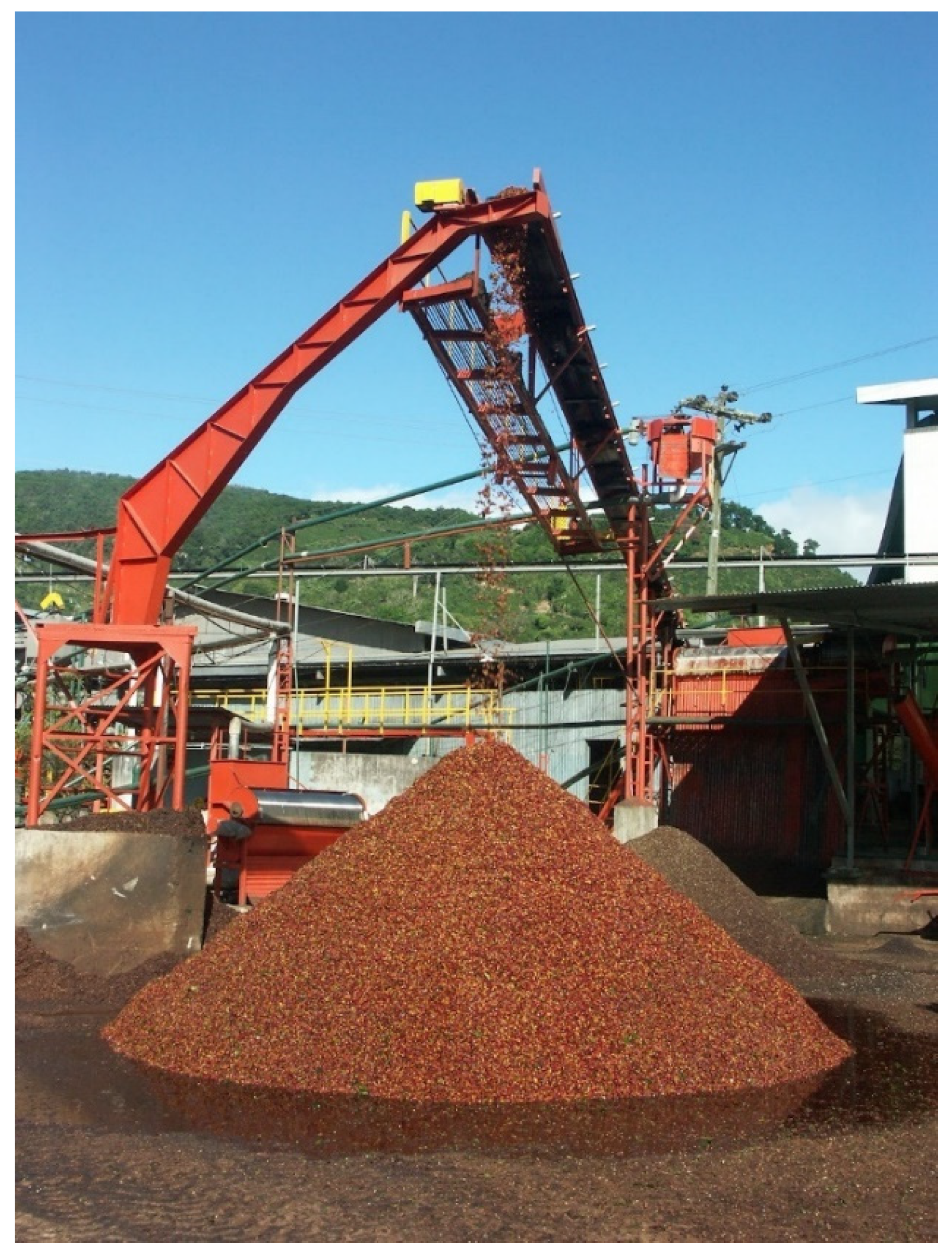
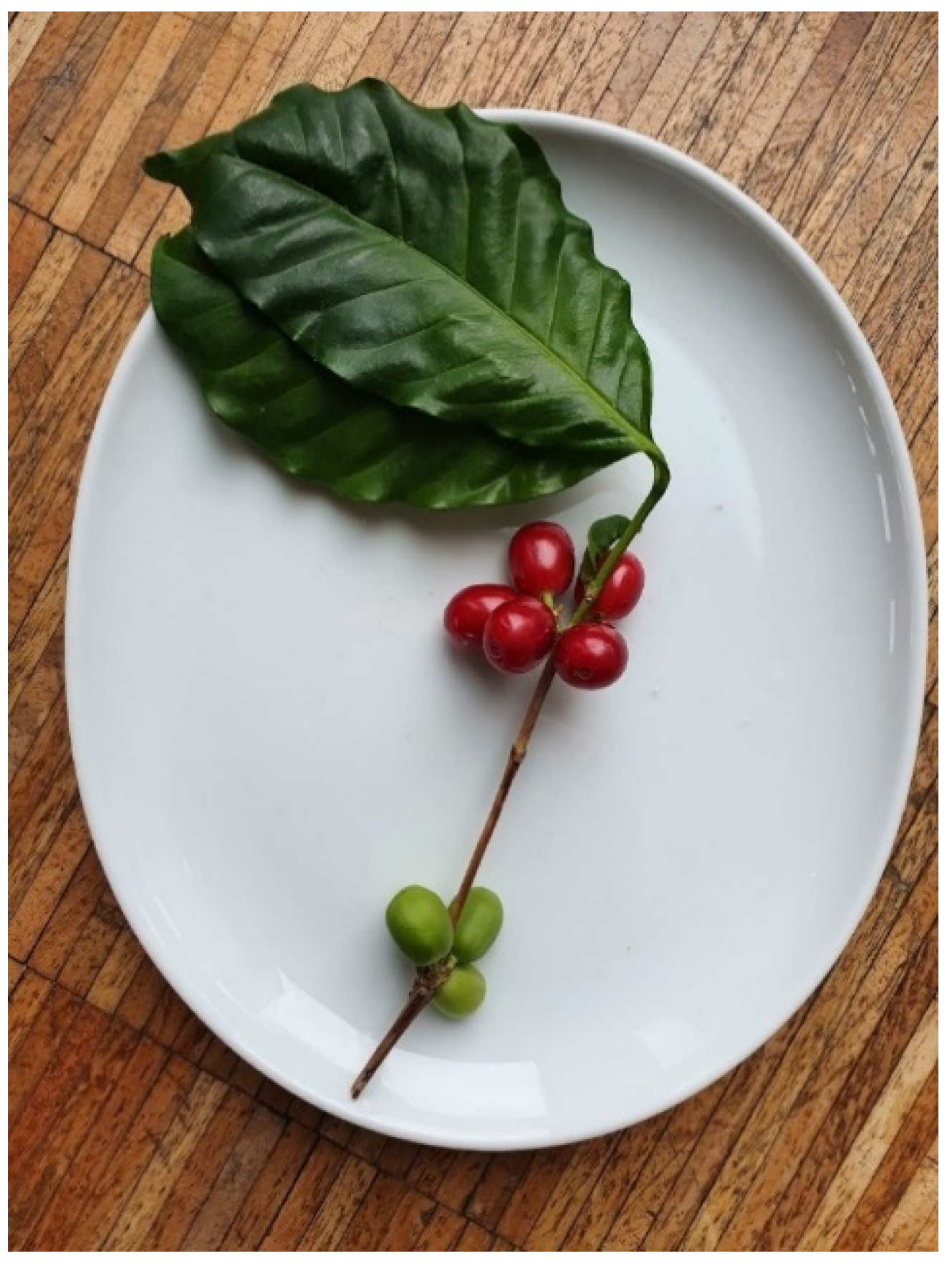
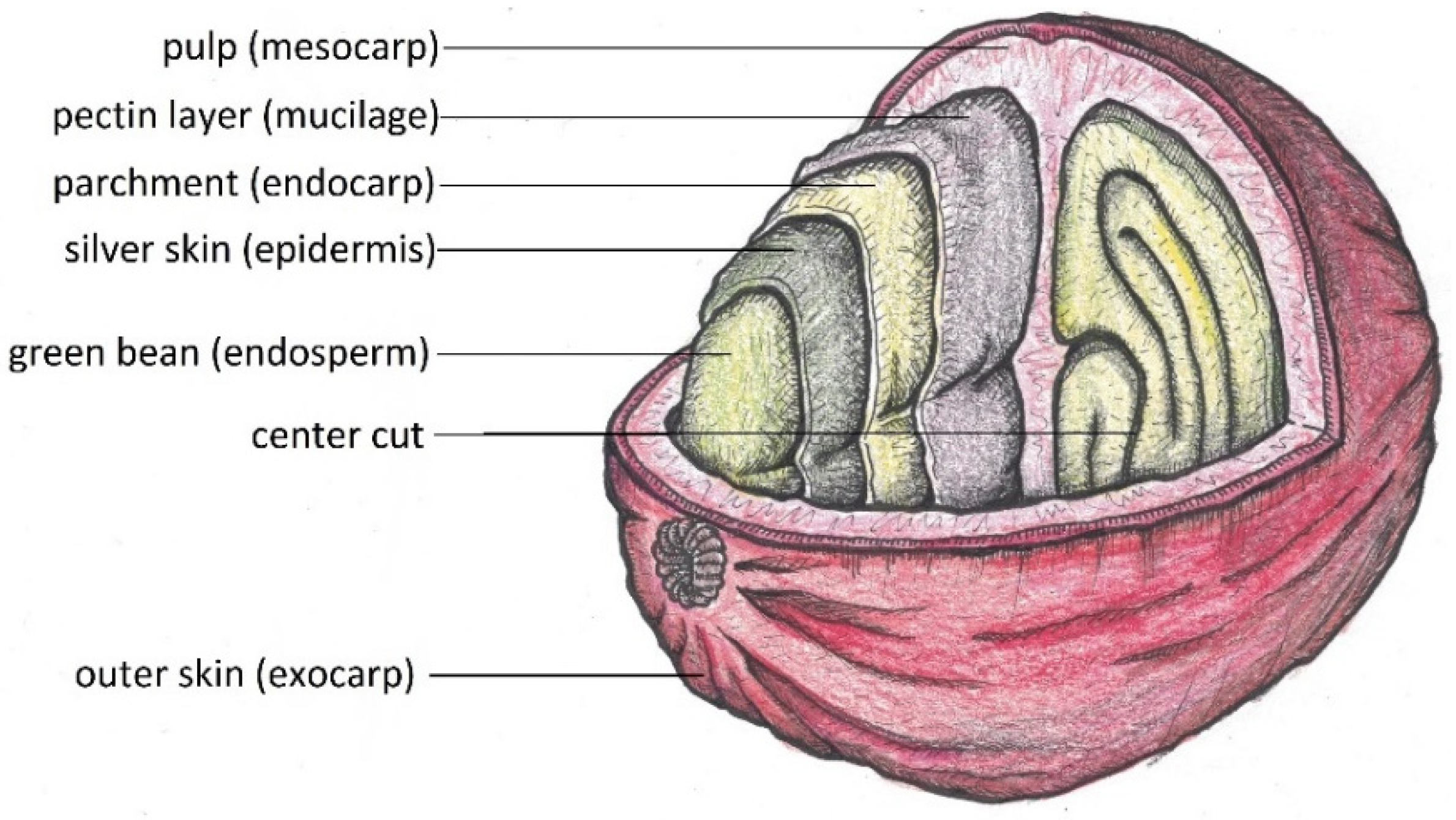
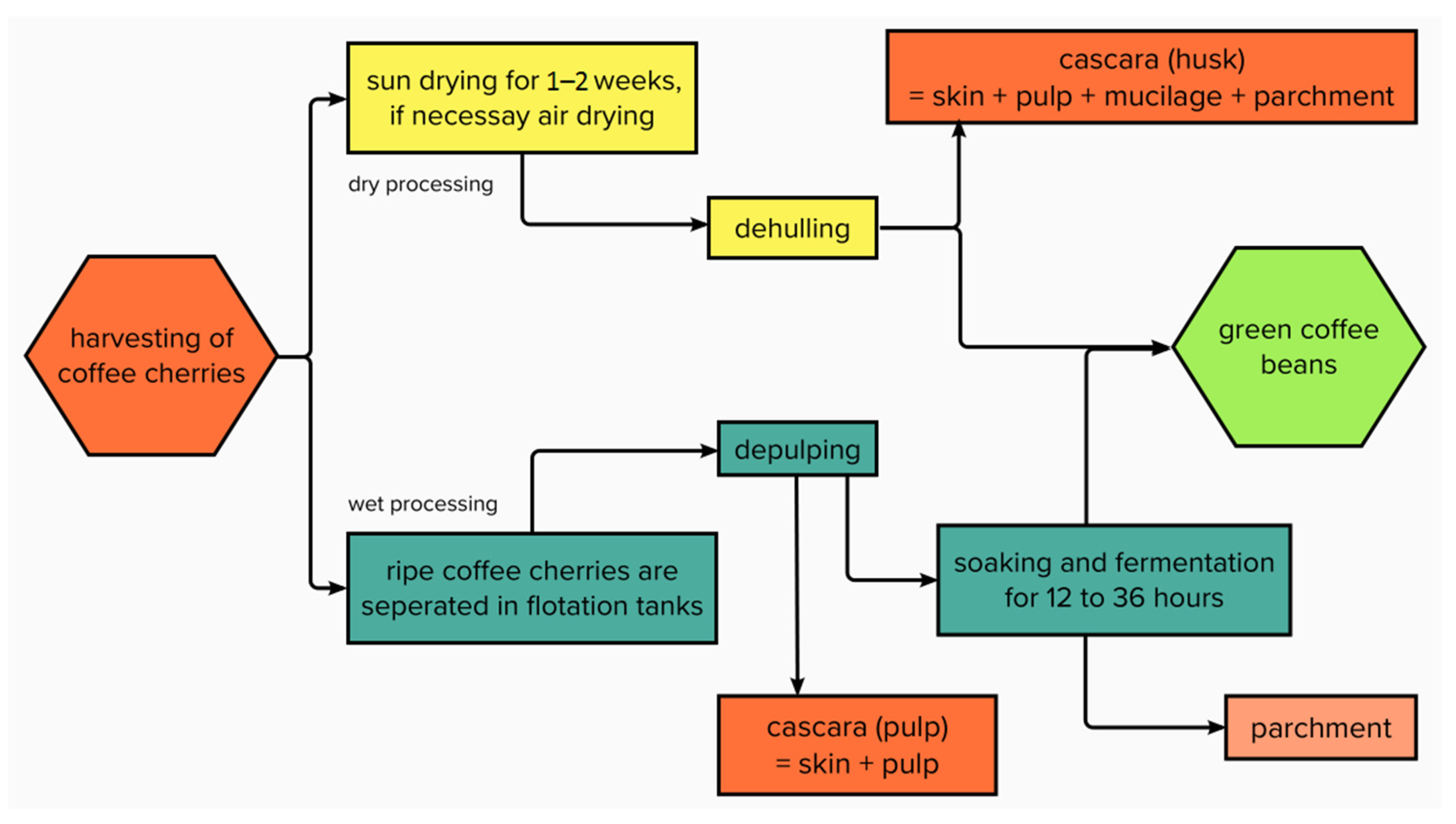
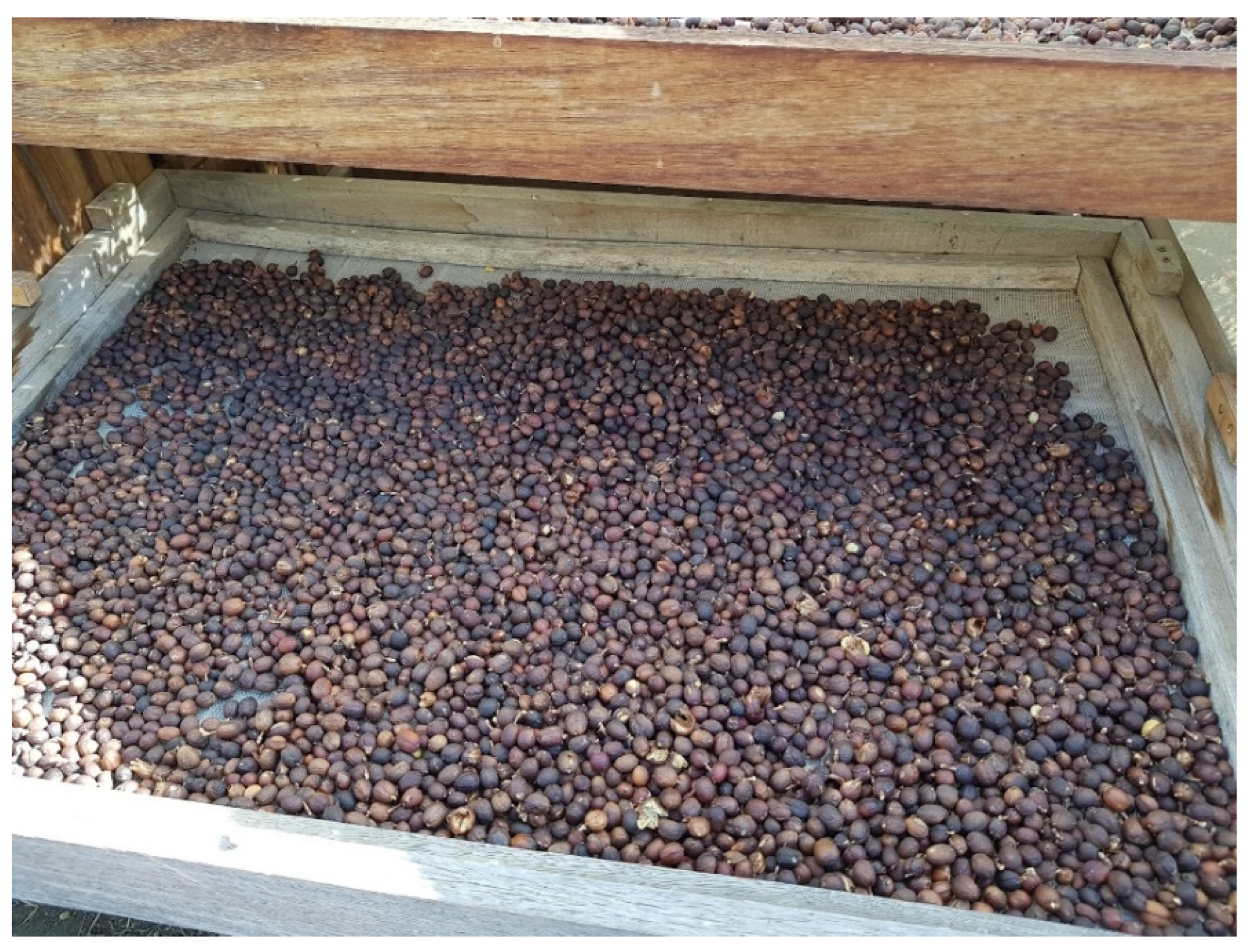
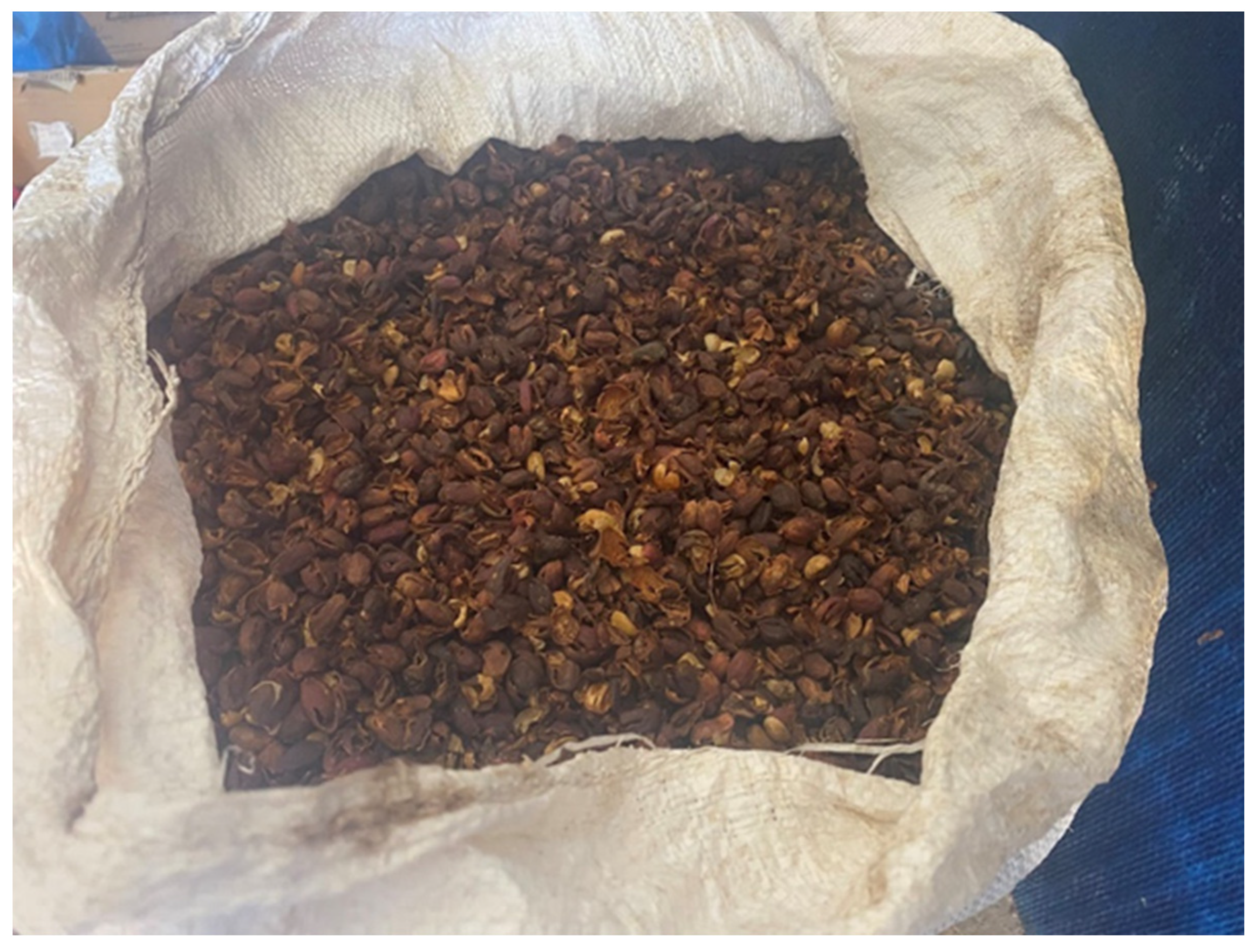
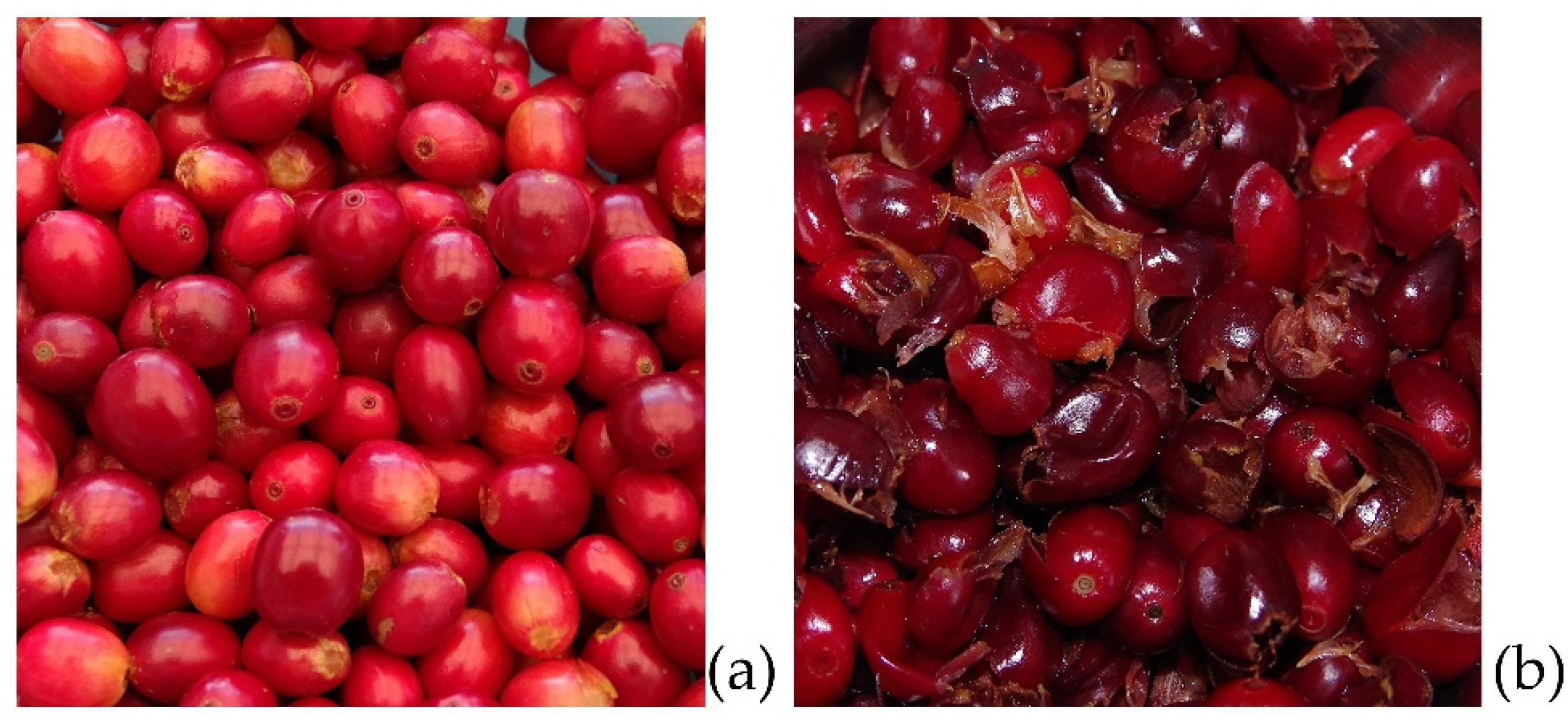
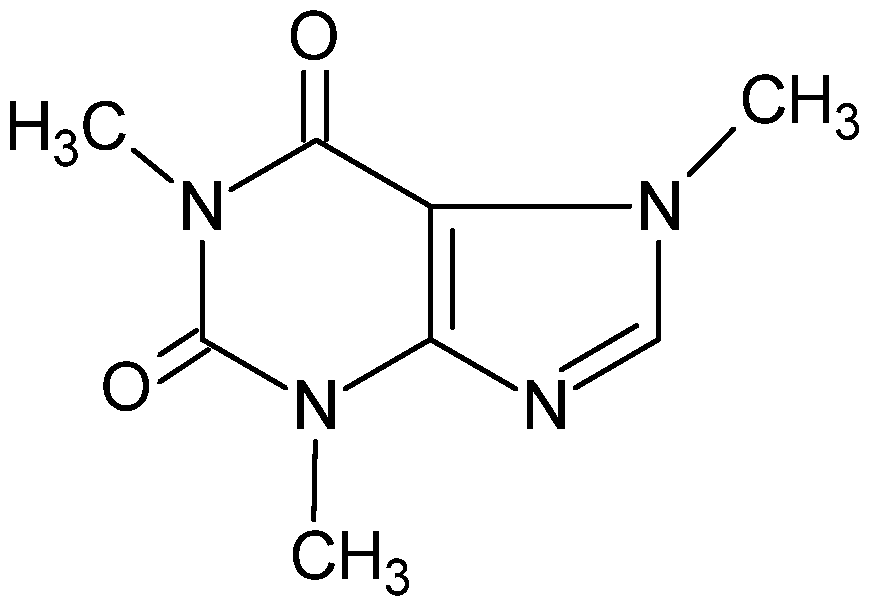
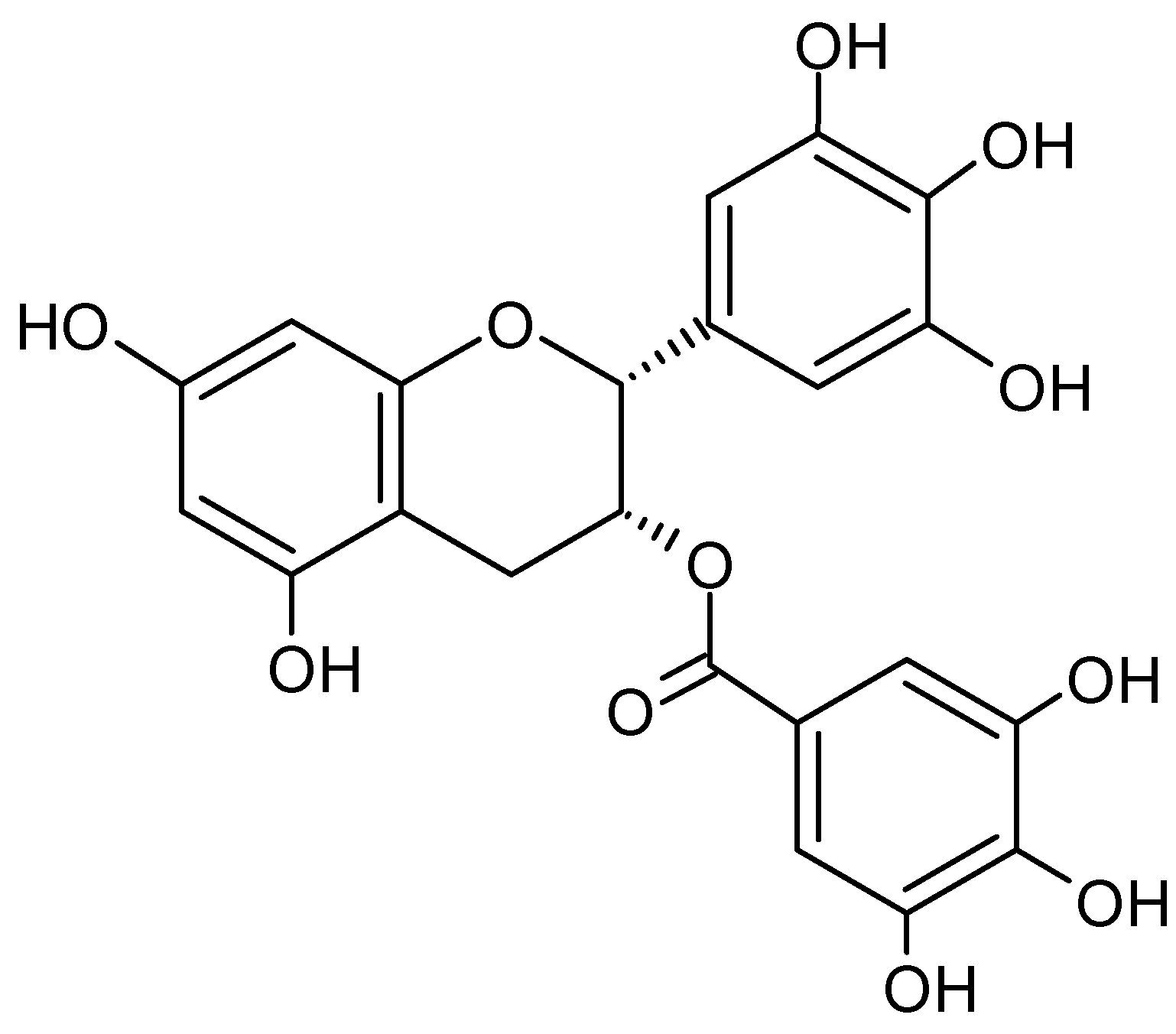
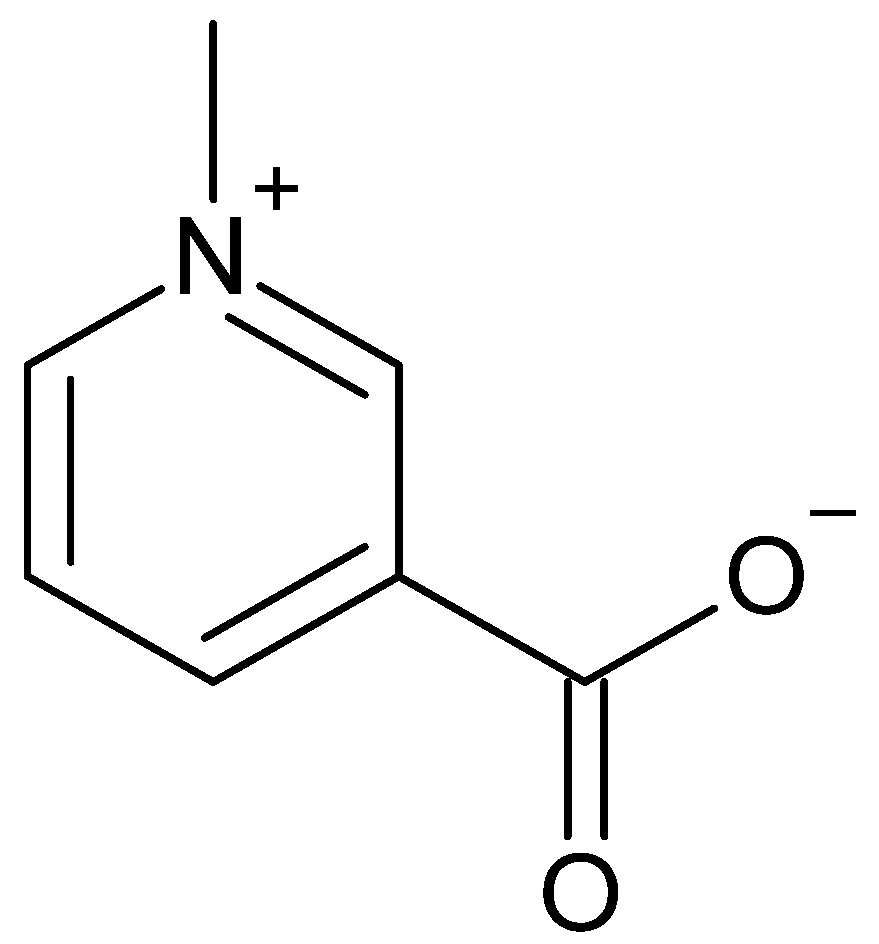
| Coffea Species | Sample Type (Sample Origin) | Converted Caffeine Content [g/kg] | Sample Preparation | Analytical Method | Source |
|---|---|---|---|---|---|
| C. arabica | Dried coffee husk (Nicaragua, Panama) | 2.0 4.6 5.3 6.5 3.5 6.4 1.4 | 3 g in 100 mL distilled water at 95 °C for 5 min | HPLC/UV | [35] |
| C. arabica | Dried cascara pulp of coffee cherries, which were kept in a bag for 12 h before pulping | 1.4 | 65.5 g in 1000 mL water at 90 °C for 6.5 min | Spectrophotometry | [1] |
| Pulp soaked in water for 12 h | 1.8 | ||||
| Pulp left in a basket for 12 h | 2.5 | ||||
| Pulp/husk of dry processed coffee | 3.7 | ||||
| pulp of wet processed coffee (Indonesia) | 4.5 | ||||
| C. arabica | Air-dried coffee husk (Mexico, India) | 1.3 2.2 | Coffee sample was ground to a fine powder; 20–30 mg extracted with 50% ethanol/water (7 mL) by vortexing the contents for 10 min followed by centrifugation; supernatant was transferred; the extraction was repeated 5 times; 5 mL-aliquots were freeze dried and reconstituted in 500 μL of methanol/0.1% formic acid | LC-MS | [36] |
| C. canephora | Air-dried coffee husk (Mexico, India) | 0.9 1.0 | Same as above | LC-MS | [36] |
| C. arabica (wet processed) | Coffee cherry pulp powder (Thailand) | 0.0882 | Chemical composition analysis: 1 g in 250 mL water at 90 °C for 20 min with 5.0 g of MgO | HPLC-DAD | [37] |
| Conventional extraction: Distilled water was added to the dried coffee cherry pulp powder at a ratio of 1:20 (w/v) with a 15 min holding time at room temperature followed by heating in a water bath | |||||
| 0.0214 | 80 °C for 1 min | ||||
| 0.0186 | 80 °C for 3 min | ||||
| 0.0208 | 80 °C for 5 min | ||||
| 0.0186 | 90 °C for 1 min | ||||
| 0.0266 | 90 °C for 3 min | ||||
| 0.0254 | 90 °C for 5 min | ||||
| 0.0274 | 100 °C for 1 min | ||||
| 0.0204 | 100 °C for 3 min | ||||
| 0.0328 | 100 °C for 5 min | ||||
| C. canephora (wet processed) | Coffee cherry pulp powder (Thailand) | 0.0137 0.0038 0.0052 0.0052 0.0050 0.0062 0.0064 0.0064 0.0070 0.0078 | Same as above | HPLC-DAD | [37] |
| C. arabica (wet processed) | Cascara | Infusing 60.0 g of ground cascara in 600 mL deionized water at 93 °C for 5 min, then cooled in ice bath for 10 min, then filtered | HPLC | [38] | |
| (Brazil | 3.2 | ||||
| El Salvador | 2.1 | ||||
| Guatemala 1 | 3.5 | ||||
| Papua New Guinea | 3.7 | ||||
| Guatemala 2) | 2.1 | ||||
| C. arabica (dry processed) | 80% pulp + 20% parchment | 6.2 | Blanching: in water at 90 °C for 1 min 0.1 g in 10 mL boiling water; samples were conditioned in a Dubnoff bath at 100 °C for 10 min | HPLC | [39] |
| 80% pulp + 20% parchment blanched | 5.2 | ||||
| 28% pulp + 72% parchment | 7.0 | ||||
| 28% pulp + 72% parchment blanched (Brazil) | 4.2 | ||||
| C. arabica (wet processed) | Castillo | 5.3 | 1.0 g in 20 mL of water for 15 min at 85 °C in a water bath and stirred on a magnetic plate for 10 min, then centrifuged | HPLC-DAD | [40] |
| Colombia | 7.2 | ||||
| Caturra | 7.7 | ||||
| (Colombia) |
| Coffea Species | Sample Type | Trigonelline Content [g/kg] | Sample Preparation | Analytical Method | Source |
|---|---|---|---|---|---|
| C. arabica (dry-processed) | 80% pulp + 20% parchment 80% | 5.4 | Blanching: in water at 90 °C for 1 min; 0.1 g in 10 mL boiling water; samples were conditioned in a Dubnoff bath at 100 °C for 10 min | HPLC | [39] |
| Pulp + 20% parchment blanched | 2.9 | ||||
| 28% pulp + 72% parchment | 2.5 | ||||
| 28% pulp + 72% parchment blanched | 1.2 |
| Size | Caffeine (mg) | Trigonelline (mg) |
|---|---|---|
| 1 kg | 399 | 567 |
| 1 glass (450 g) | 180 | 255 |
| 1 large spoon (20 g, 1 portion) | 8 | 11 |
| Cola soft drink (255 mL) | 29.5 [64] | n.a |
| Cup of coffee (255 mL) | 74 [65] | n.a. |
| Sweet chocolate (28 g) | 20 [66] | n.a. |
| Age Class | Safe Single Dose [32] | Acceptable Daily Intake ADI [32] | Caffeine Intake in mg/day (mg/kg bw) | Source | |
|---|---|---|---|---|---|
| Mean | P95 | ||||
| Toddlers 12 to <36 months | n.a. | n.a. | 5.9 (0.5) | 27.3 (2.2) | VELS |
| Other children 3 to <10 years | 3 mg/kg bw | 5.7 mg/kg bw | 13.5 (0.8) | 47.4 (2.6) | VELS |
| Adolescents 10 to <18 years | 3 mg/kg bw | 5.7 mg/kg bw | 59.4 (1.0) | 208.1 (3.5) | NVS II |
| Adults 18 to <65 years | 200 mg (3 mg/kg bw) | 400 mg (5.7 mg/kg bw) | 238.0 (3.2) | 538.7 (7.3) | NVS II |
| Elderly 65 to <75 years | 200 mg (3 mg/kg bw) | 400 mg (5.7 mg/kg bw) | 241.4 (3.2) | 486.4 (6.3) | NVS II |
| Very elderly ≥75 years | 200 mg (3 mg/kg bw) | 400 mg (5.7 mg/kg bw) | 208.2 (2.8) | 397.9 (5.2) | NVS II |
| Population group | |||||
| Pregnant women | n.a. | 200 mg | |||
| Lactating women | 200 mg | 200 mg | |||
| Food | Caffeine | EGCG | Trigonelline | Safe Intake of Food a | |
|---|---|---|---|---|---|
| Juice | 70–300 mg/L | n.a. | 100–600 mg/L | 43–10 mL/kg bw | |
| Jam | 399 mg/kg | n.a. | 567 mg/kg | 7.5 g/kg bw | |
| Jelly | 399 mg/kg | n.a | 567 mg/kg | 7.5 g/kg bw | |
| Processed puree Unprocessed puree | 400 mg/kg 480 mg/kg | n.a. | 540 mg/kg 650 mg/kg | 7.5 g/kg bw 6.3 g/kg bw | |
| Wheat bread 2.5% CCHP | 100 mg/kg | n.a. | 135 mg/kg | 30 g/kg bw | |
| Egyptian flatbread 5% CCHP 10% CCHP 15% CCHP | Authors Measured value | Mean value (this study) | n.a. | 19 mg/125 g 37 mg/125 g 56 mg/125 g | 3–14 pcs 1–7 pcs 1–4 pcs |
| 63 mg/125 g 125 mg/125 g 188 mg/125 g | 14 mg/125 g 28 mg/125 g 41 mg/125 g | ||||
Publisher’s Note: MDPI stays neutral with regard to jurisdictional claims in published maps and institutional affiliations. |
© 2022 by the authors. Licensee MDPI, Basel, Switzerland. This article is an open access article distributed under the terms and conditions of the Creative Commons Attribution (CC BY) license (https://creativecommons.org/licenses/by/4.0/).
Share and Cite
Eckhardt, S.; Franke, H.; Schwarz, S.; Lachenmeier, D.W. Risk Assessment of Coffee Cherry (Cascara) Fruit Products for Flour Replacement and Other Alternative Food Uses. Molecules 2022, 27, 8435. https://doi.org/10.3390/molecules27238435
Eckhardt S, Franke H, Schwarz S, Lachenmeier DW. Risk Assessment of Coffee Cherry (Cascara) Fruit Products for Flour Replacement and Other Alternative Food Uses. Molecules. 2022; 27(23):8435. https://doi.org/10.3390/molecules27238435
Chicago/Turabian StyleEckhardt, Sara, Heike Franke, Steffen Schwarz, and Dirk W. Lachenmeier. 2022. "Risk Assessment of Coffee Cherry (Cascara) Fruit Products for Flour Replacement and Other Alternative Food Uses" Molecules 27, no. 23: 8435. https://doi.org/10.3390/molecules27238435
APA StyleEckhardt, S., Franke, H., Schwarz, S., & Lachenmeier, D. W. (2022). Risk Assessment of Coffee Cherry (Cascara) Fruit Products for Flour Replacement and Other Alternative Food Uses. Molecules, 27(23), 8435. https://doi.org/10.3390/molecules27238435











